PR
X
Keyword Search
▼キーワード検索
Comments
続日本100名城東北の…
New!
オジン0523さん
【甥のステント挿入… New!
Gママさん
New!
Gママさん
2025年版・岡山大学… New!
隠居人はせじぃさん
New!
隠居人はせじぃさん
ムベの実を開くコツ… noahnoahnoahさん
noahnoahnoahさん
エコハウスにようこそ ecologicianさん
【甥のステント挿入…
 New!
Gママさん
New!
Gママさん2025年版・岡山大学…
 New!
隠居人はせじぃさん
New!
隠居人はせじぃさんムベの実を開くコツ…
 noahnoahnoahさん
noahnoahnoahさんエコハウスにようこそ ecologicianさん
Calendar
カテゴリ: 海外旅行
「 Kylemore’s Neo-Gothic Church
」を訪ねたの後に、さらにその先の 博物館「Mausoleum」
を
訪ねる予定であったが、時間の関係上諦めた のであった。
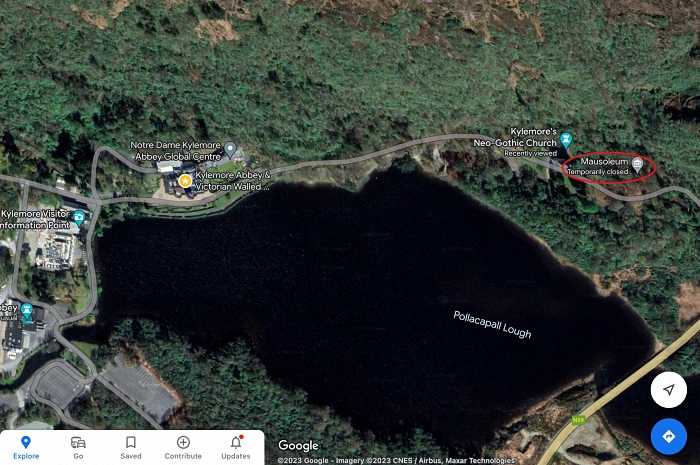
ネットから 霊廟(れいびょう)「Mausoleum」 の写真を。

「 Kylemore Abbey & Victorian Walled Garden
訪ねる予定であったが、時間の関係上諦めた のであった。

ネットから 霊廟(れいびょう)「Mausoleum」 の写真を。

「 Kylemore Abbey & Victorian Walled Garden
Mausoleum
Here lies the remains of Margaret Henry 1829–1874 who died tragically while on holiday
in Egypt just 4 years after the castle at Kylemore was constructed.
in Egypt just 4 years after the castle at Kylemore was constructed.
Her body was brought back to Kylemore by her husband Mitchell Henry.
Mitchell Henry 1826–1910, who built Kylemore Castle, died in England.
His ashes were brought back to Kylemore and laid to rest next to his beloved wife
Margaret in accordance with his final wishes.
Margaret in accordance with his final wishes.
The remains of John Henry, a grandnephew of Mitchell Henry who died 13th February 1989, were laid to rest in the mausoleum.」
【カイルモア修道院 & ヴィクトリア朝の囲い庭園
霊廟(れいびょう)
ここには、マーガレット・ヘンリー(1829年–1874年)の遺骨が埋葬されています。
彼女は、カイルモア城が完成してからわずか4年後、エジプトでの休暇中に悲劇的な死を
遂げました。その遺体は、夫であるミッチェル・ヘンリーの手によってカイルモアに運ばれました。
ミッチェル・ヘンリー(1826年–1910年)はカイルモア城を建てた人物で、イングランドで
亡くなりました。
彼の遺灰は遺志によりカイルモアに持ち帰られ、愛する妻マーガレットの隣に安置されました。
また、この霊廟には、ミッチェル・ヘンリーの又甥(またおい)にあたる
ジョン・ヘンリー(1989年2月13日没)の遺骨も共に埋葬されています。】
この写真もネットから。

よって「 Kylemore’s Neo-Gothic Church 」迄とし、引き返す。
ウィッチ・エルム(ニレの一種) 。

「 MEET THE ELM
Neolithic times.」
【 ニレの木に出会う(Wych Elm)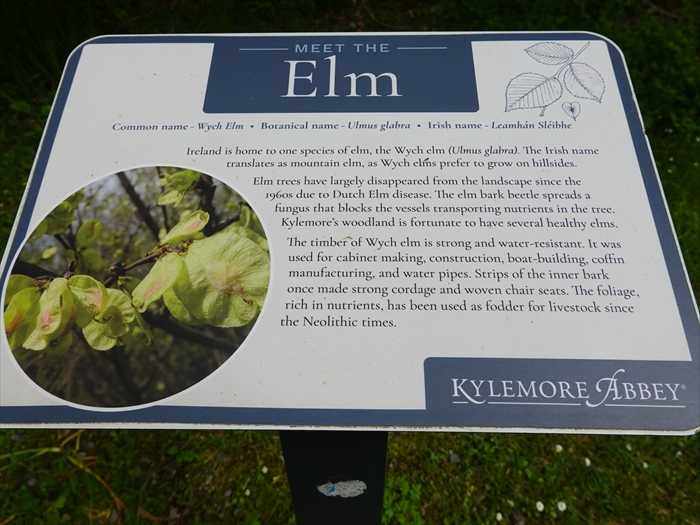
「 The Boathouse 」の建物の遺跡。
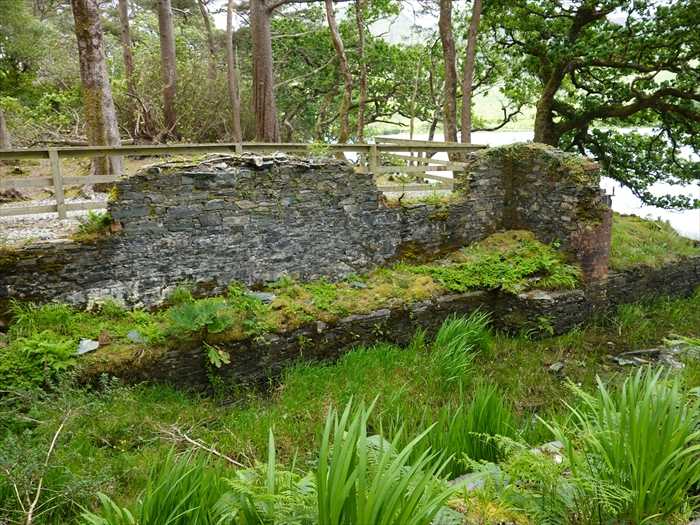
「 The Boathouse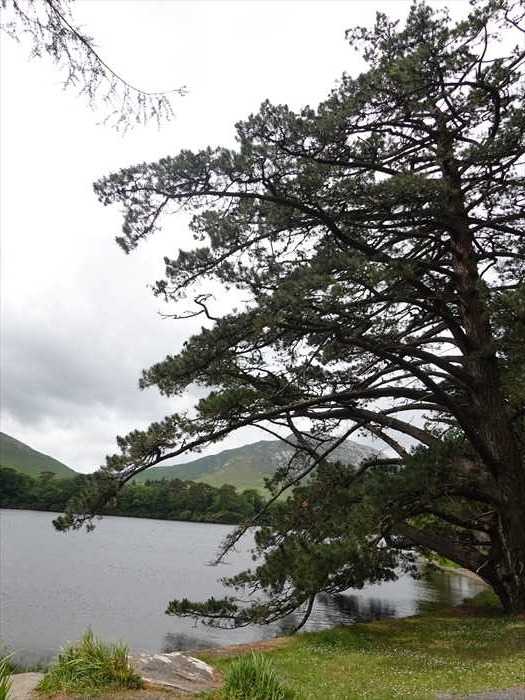
「THE Rowan・ ナナカマド」 。
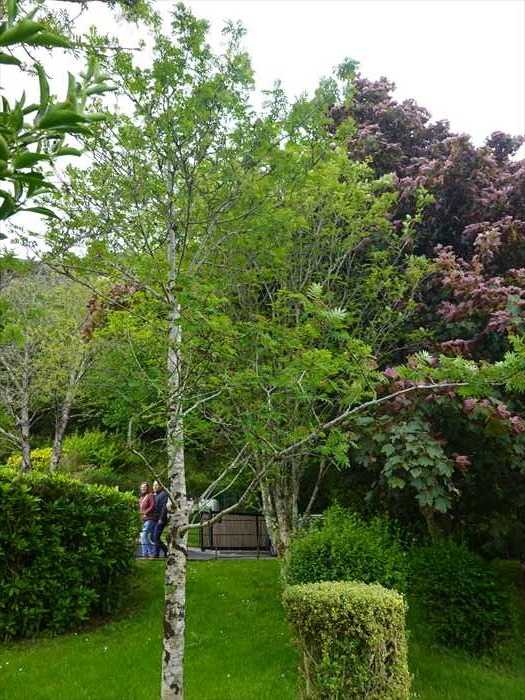
「 MEET THE Rowan
【 ローワンの木(ナナカマド)に出会う
ナナカマドと白樺は、どちらも北国の風景を彩る代表的な木ですが、それぞれ異なる特徴を
持っているのだ と。

帰路には「カイルモア修道院(Kylemore Abbey)」の前の 湖岸の路 を引き返す。
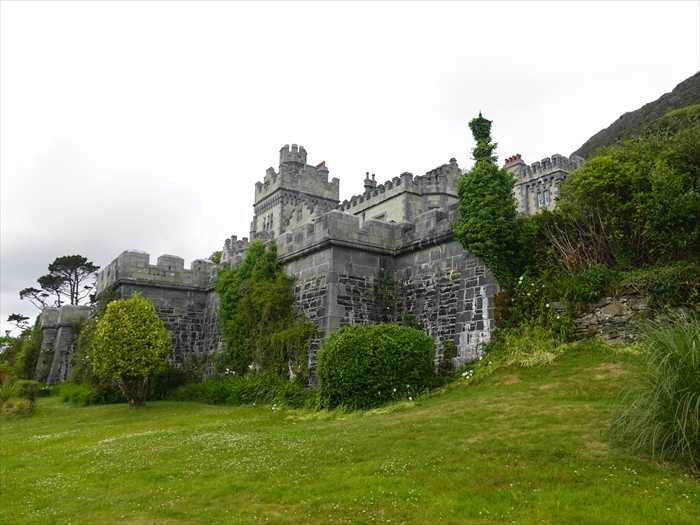
「 Lake Walk
【カイルモア修道院 & ヴィクトリア朝の囲い庭園
霊廟(れいびょう)
ここには、マーガレット・ヘンリー(1829年–1874年)の遺骨が埋葬されています。
彼女は、カイルモア城が完成してからわずか4年後、エジプトでの休暇中に悲劇的な死を
遂げました。その遺体は、夫であるミッチェル・ヘンリーの手によってカイルモアに運ばれました。
ミッチェル・ヘンリー(1826年–1910年)はカイルモア城を建てた人物で、イングランドで
亡くなりました。
彼の遺灰は遺志によりカイルモアに持ち帰られ、愛する妻マーガレットの隣に安置されました。
また、この霊廟には、ミッチェル・ヘンリーの又甥(またおい)にあたる
ジョン・ヘンリー(1989年2月13日没)の遺骨も共に埋葬されています。】
この写真もネットから。

よって「 Kylemore’s Neo-Gothic Church 」迄とし、引き返す。
ウィッチ・エルム(ニレの一種) 。

「 MEET THE ELM
Common name – Wych Elm Botanical name – Ulmus glabra
Irish name – Leamhán Sléibhe
Irish name – Leamhán Sléibhe
Ireland is home to one species of elm, the Wych elm (Ulmus glabra).
The Irish name translates as mountain elm, as Wych elms prefer to grow on hillsides.
Elm trees have largely disappeared from the landscape since the 1960s due to Dutch Elm disease.
The elm bark beetle spreads a fungus that blocks the vessels transporting nutrients
in the tree.Kylemore’s woodland is fortunate to have several healthy elms.
in the tree.Kylemore’s woodland is fortunate to have several healthy elms.
The timber of Wych elm is strong and water-resistant.
It was used for cabinet making, construction, boat-building, coffin manufacturing, and
water pipes.Strips of the inner bark once made strong cordage and woven chair seats.
The foliage, rich in nutrients, has been used as fodder for livestock since thewater pipes.Strips of the inner bark once made strong cordage and woven chair seats.
Neolithic times.」
【 ニレの木に出会う(Wych Elm)
一般名:ウィッチ・エルム(ニレの一種)
学名:Ulmus glabra
アイルランド語名:Leamhán Sléibhe(山のニレ)
アイルランドに自生するニレの木は、この「ウィッチ・エルム(Ulmus glabra)」の1種だけです。
アイルランド語名は「山のニレ」という意味で、これはこの木が斜面や丘陵地を好んで生育する
ためです。
ためです。
1960年代以降、ダッチ・エルム病(オランダニレ病)の影響で、ニレの木は風景の中からほとんど
姿を消してしまいました。
姿を消してしまいました。
この病気はエルム樹皮カミキリムシによって広がり、木の内部で栄養を運ぶ導管を菌によって
詰まらせることで枯死させてしまいます。
詰まらせることで枯死させてしまいます。
しかし、カイルモアの森には幸運にも健康なニレの木が数本生育しています。
ウィッチ・エルムの木材は強靭で耐水性があり、
古くは家具作り、建築、造船、棺桶製造、そして水道管などに使われてきました。
また、内樹皮の繊維は、強い縄や椅子の座面を編む材料としても用いられていました。
さらに、栄養価の高い葉は、古代新石器時代から家畜の飼料として利用されてきました。】

「 The Boathouse 」の建物の遺跡。

「 The Boathouse
AMPLE OPPORTUNITIES FOR BOATING
"...an ornamentally-designed Boat House."
– Kylmore Book of Sale 1903
While clearing invasive rhododendron, this once beautiful picturesque building was
uncovered.It housed the pleasure boats of the Henrys and would originally have been
used for fishing or recreational boating.
uncovered.It housed the pleasure boats of the Henrys and would originally have been
used for fishing or recreational boating.
The Boathouse was built from locally quarried stone, finished with red brick and roofed
with terracotta tiles.
with terracotta tiles.
A mountain stream was cleverly diverted to have continuous fresh water running through
the boathouse to prevent algae growth.
the boathouse to prevent algae growth.
The small lake in front of the boathouse acts as a “dripping pond” – these fill with heavy
rainfall but dry up in sunny weather.
rainfall but dry up in sunny weather.
Artist impression of the Boat House
【 ボートハウス
【 ボートハウス
ボート遊びに最適な環境
「装飾的に設計されたボートハウス」
ー『カイルモア売却目録』(1903年)
外来種のシャクナゲ(ツツジ科)を伐採していた際、この美しく趣ある建物が再び姿を現しました。
この建物は、かつてヘンリー家が所有していた遊覧ボートの格納庫として使われており、釣りや
娯楽としてのボート遊びに利用されていたと考えられます。
娯楽としてのボート遊びに利用されていたと考えられます。
ボートハウスは地元で切り出された石材で建てられ、赤レンガで仕上げられ、屋根には
テラコッタ瓦が葺かれていました。
テラコッタ瓦が葺かれていました。
また、山からの小川を巧みに引き込み、建物内に常に新鮮な水が流れるように設計されており、
これによって藻類の繁殖が防がれていました。
ボートハウス前の小さな池は、「ドリッピング・ポンド(しみ出し池)」として機能しており、
大雨の際には水がたまりますが、晴天が続くと自然に乾いていきます。
( ※図:ボートハウスの復元イメージ
)】

ポラカパル湖を左に見ながら 。

ポラカパル湖を左に見ながら 。

「THE Rowan・ ナナカマド」 。

「 MEET THE Rowan
Common name – Rowan Botanical name – Sorbus aucuparia (bird catcher)
Irish name – Caorthann
Irish name – Caorthann
The rowan is sometimes called the mountain ash. But, despite a similar leaf shape,
the rowan is not related to the ash.
the rowan is not related to the ash.
The “mountain” part of the name is apt however, as the rowan is the only deciduous tree
that can grow at high altitude (up to 900m) in the Irish landscape.
that can grow at high altitude (up to 900m) in the Irish landscape.
Because the rowan can grow in remote areas and bears bright red berries, it is a valuable
food source for birds, especially migrating birds.
food source for birds, especially migrating birds.
The rowan seed must pass through a bird or animal gut in order to germinate.
Rowan berries are too acidic and bitter to eat raw
but once boiled, the acid breaks down, and can be
used to make a delicious jelly rich in Vitamin C.」 【 ローワンの木(ナナカマド)に出会う
一般名:ローワン(ナナカマド)
学名:Sorbus aucuparia(鳥を捕まえる=鳥寄せの意)
アイルランド語名:Caorthann(カーフラン)
ローワンの木は、しばしば「マウンテン・アッシュ(山のトネリコ)」と呼ばれますが、
葉の形が似ているだけで、実際にはトネリコとは関係がありません。
「山(マウンテン)」という名は適切で、ローワンはアイルランドの風景の中で、
標高900メートルまで育つ唯一の落葉樹です。
標高900メートルまで育つ唯一の落葉樹です。
ローワンは人里離れた場所でも育ち、鮮やかな赤い実をつけるため、
特に渡り鳥など多くの鳥にとって貴重な食料源となっています。
なお、ローワンの種子は、発芽するために一度鳥や動物の消化管を通過しなければなりません。
ローワンの実はそのままだと酸味が強く苦いため食用には適しませんが、
加熱することで酸が分解され、ビタミンCが豊富な美味しいゼリーに加工できます。】ナナカマドと白樺は、どちらも北国の風景を彩る代表的な木ですが、それぞれ異なる特徴を
持っているのだ と。

帰路には「カイルモア修道院(Kylemore Abbey)」の前の 湖岸の路 を引き返す。

「 Lake Walk
Water and Connemara are synonymous.
The region is named after an ancient tribe: Conmhaicne Mara, the ‘Con Mhac’ of the sea.
The Atlantic Ocean borders its jagged coastline; the land is rich in freshwater bodies and
blessed with high annual rainfall.
The Atlantic Ocean borders its jagged coastline; the land is rich in freshwater bodies and
blessed with high annual rainfall.
Mountain lakes and streams feed into the three large lakes of Kylemore Valley. The largest
lake is Kylemore Lake, followed by Pollacapall (the lake in front of Kylemore Abbey) and
Lough Maladrolaun. The Victorian Walled Garden is irrigated by Lough Touther, situated
just above the garden.
lake is Kylemore Lake, followed by Pollacapall (the lake in front of Kylemore Abbey) and
Lough Maladrolaun. The Victorian Walled Garden is irrigated by Lough Touther, situated
just above the garden.
Lough Touther was used to generate electricity in Kylemore Castle in 1893. Engineers
from J. G. Howell of London designed and installed the hydro-electrical system in a small powerhouse west of the castle. We hope to reinstate hydropower in the near future to
harness sustainable green energy.」
【 湖の散策路(Lake Walk)
カイルモアの谷には三つの大きな湖(カイルモア湖、ポラカパル湖、マラドローラン湖)があり、
周囲の山からの小川が注ぎ込んでいます。
この地方は古代の部族「コンワイクネ・マーラ(海の民)」にちなんで名付けられ、大西洋に面し、
淡水と雨量に恵まれた地域です。
中でもラフ・タウザー湖(Lough Touther)は1893年、カイルモア城で水力発電に利用されました。
今後、再びこの水力発電を導入し、持続可能な再生エネルギー源として活用する予定です。】
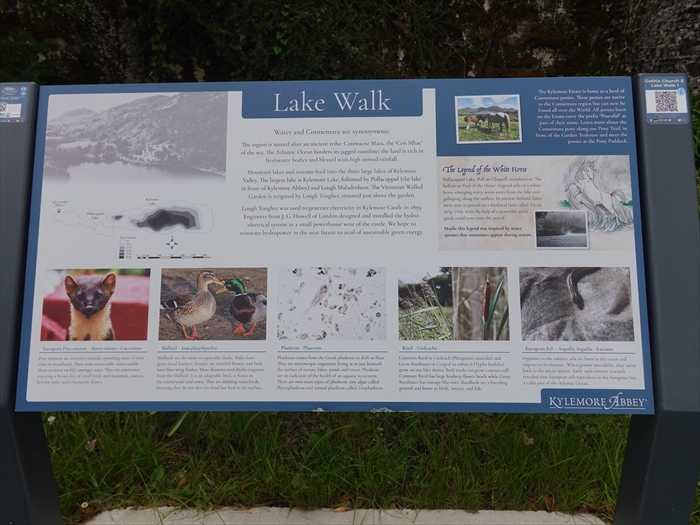
モンテレー・パイン(Monterey Pine / Pinus radiata) であっただろうか?
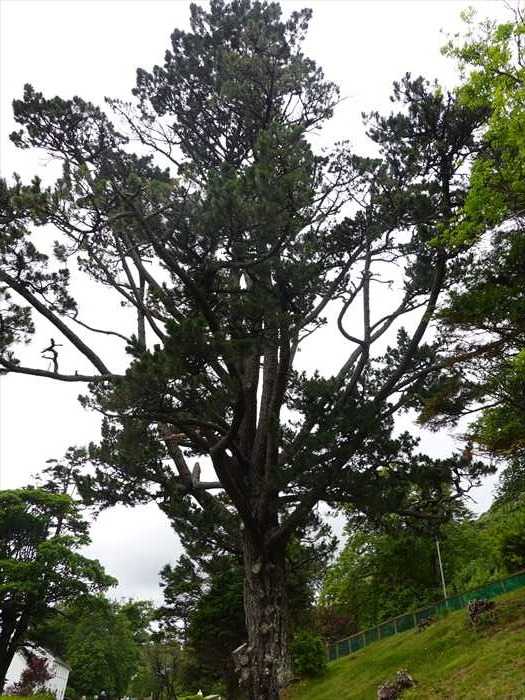
そして再び カイルモア修道院・Kylemore Abbey を振り返る。

いつまでもいたい空間と時間なのであった。
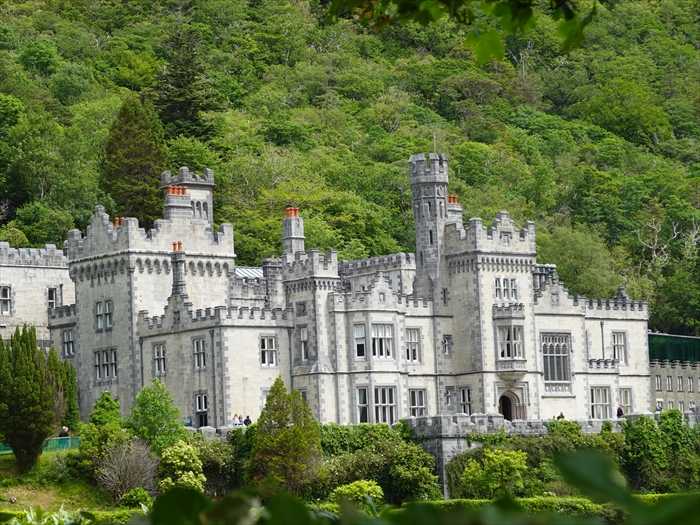
そして レストランにて昼食 を。 時間は12:30過ぎ 。
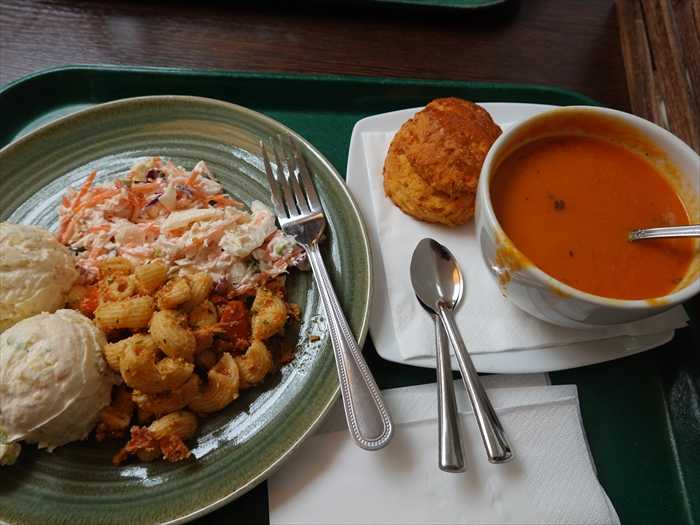
駐車場に戻り、 この日の午後の目的地の「Cong Abbey」に向かってN59を西に向かって
進む 。

走行ルート図。
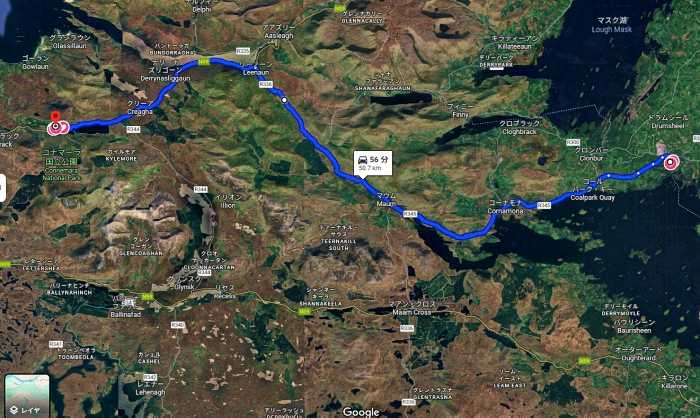
Kylemore Lough・カイルモア湖を右に見ながら 進む。

Kylemore Lough・カイルモア湖 の奥にそびえる大きな山の名は
ドゥールルー(Doughruagh)/デューホルーチ(Dúchruach) であろうか。

ズームして。
手前にはドゥールルーの北側から続く、なだらかな稜線の連なりが見えた。
ガラウン山群(Garraun Complex)の一部 で、標高約598 mのガラウン山が代表峰。
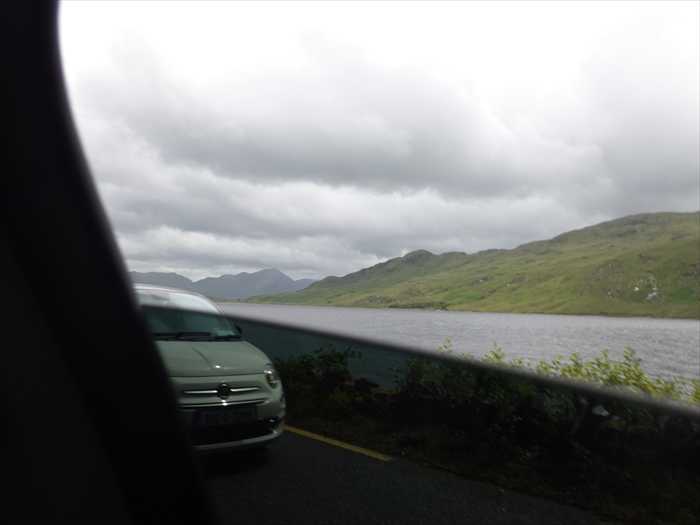
ガラウン山群(Garraun Complex) を追う。
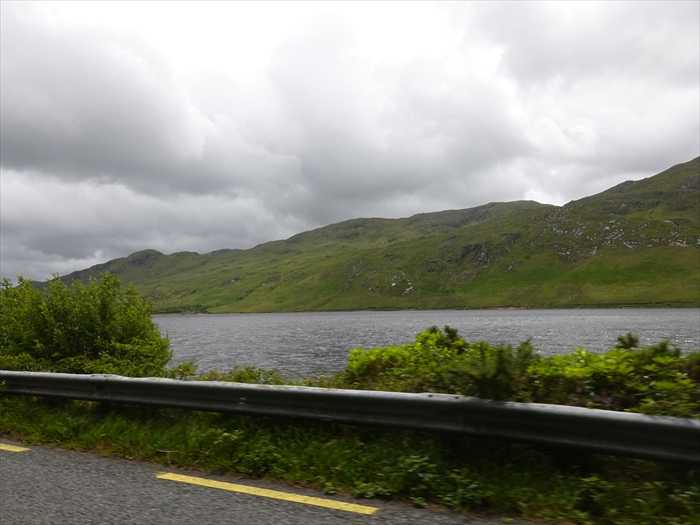
対岸の ガラウン山群(Garraun Complex)の山腹の白い場所は石灰岩が剥き出し
になっている場所なのであろうか!?

Kylemore Lough・カイルモア湖 の中央付近の湖岸を走る。
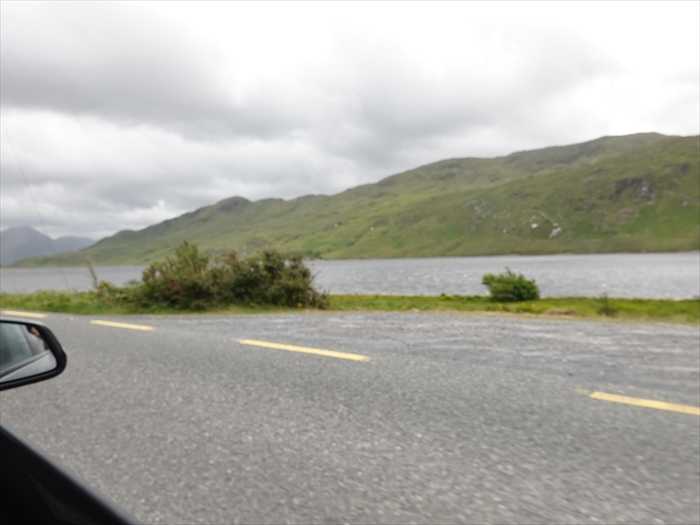
更に10分ほど進むと、坂の下、前方に現れたのが、アイルランド唯一のフィヨルド、
北大西洋に繋がっている壮大なキラリー港の入江。

前方に見えたのは、サーモン?マス? の養殖場 であっただろうか。
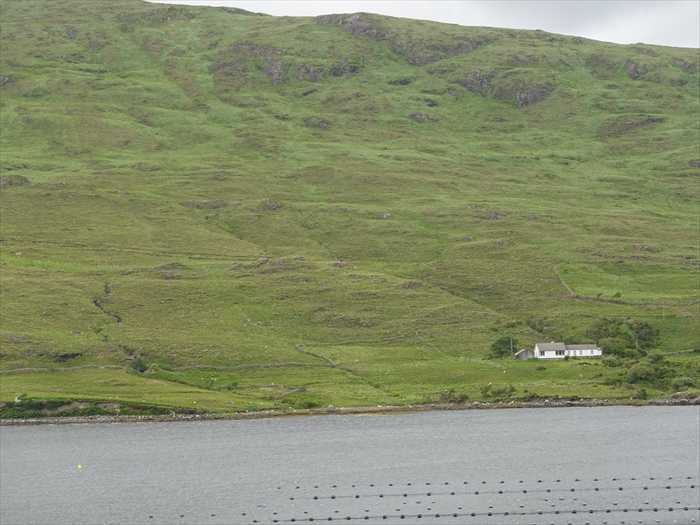
ズームして。

Aasleagh・アアズリー方向 の山並みを見る。
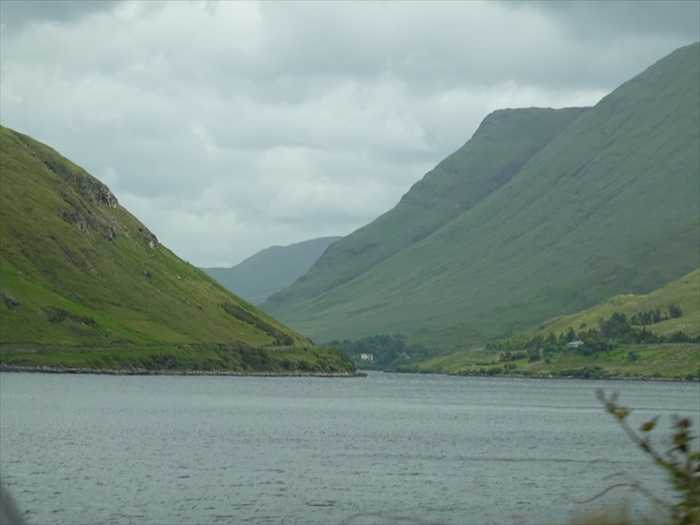
右手に見えたのはアパート?ホテル?

ホテルのようであったが?
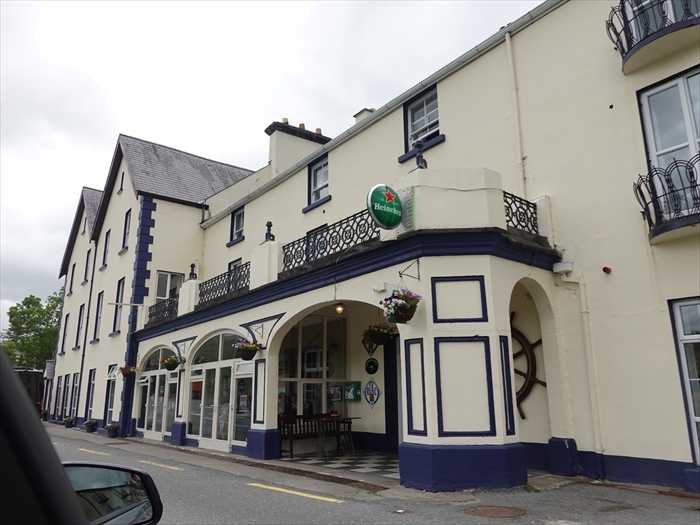
その先の、 「leenaun(リーノーン)」のT字路を右折してR336に入る 。
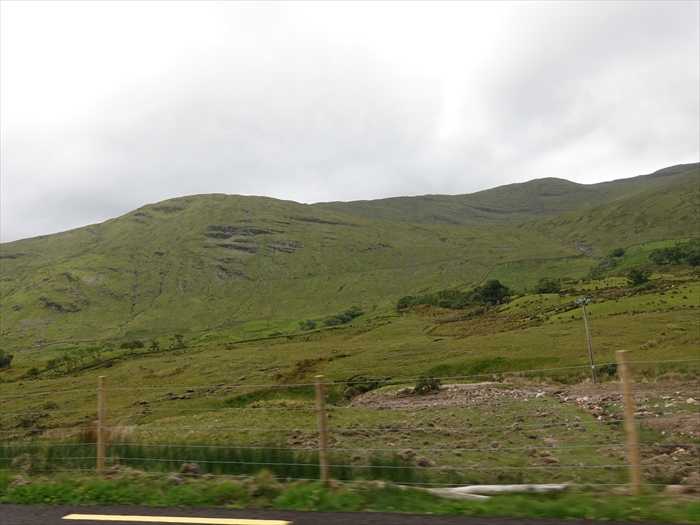
山々は牧草に覆われて緑一色。

Maumturk Mountains(マウムターク山脈)の山々を見る。

この山並みは「 lungnabrick SW top 454m 」周辺であっただろうか。
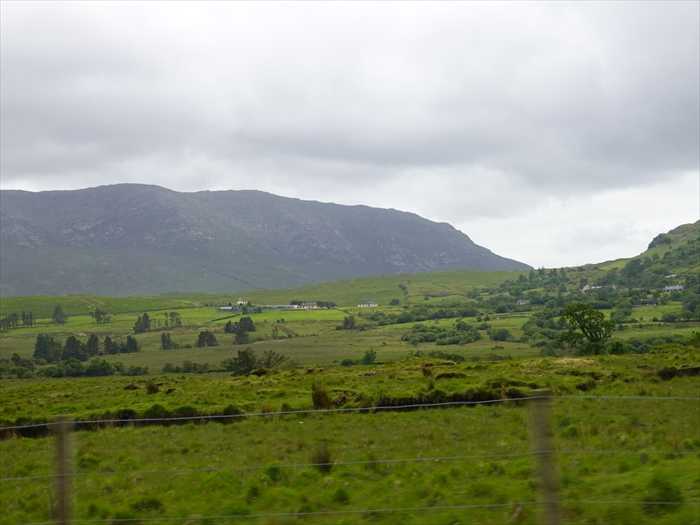
R336をひたすら走る。
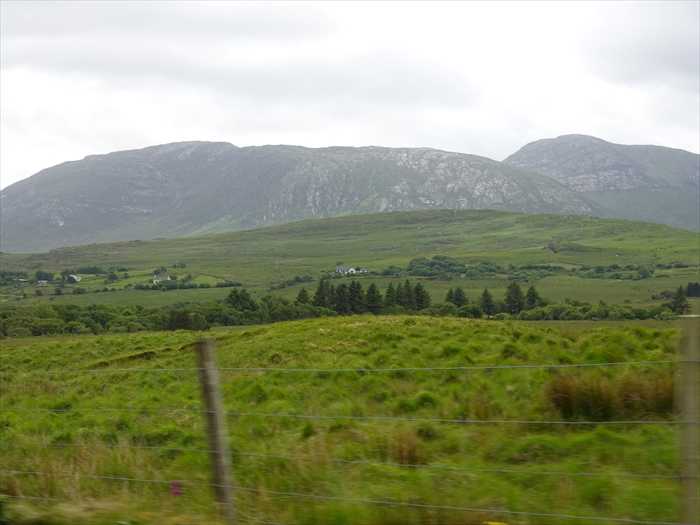
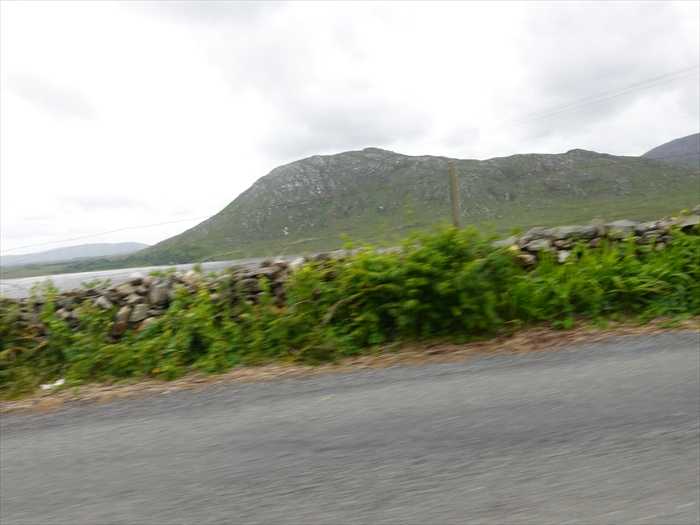
Maumを通過し、R345 を更に進む。
Lough Corrib・コリブ湖が 右手に現れた。

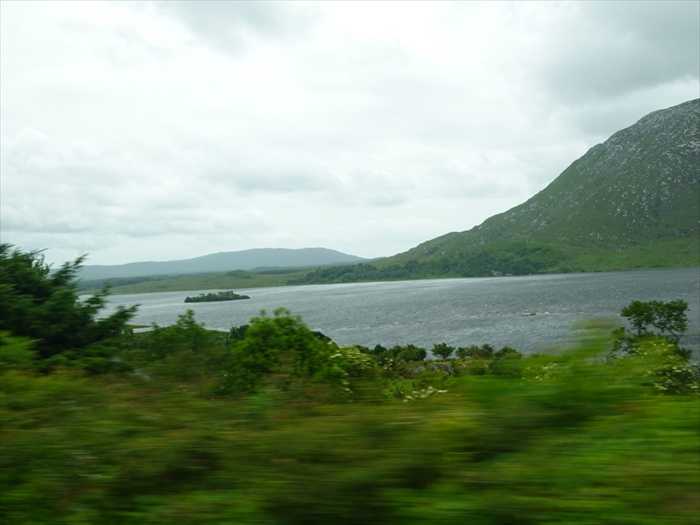
ゴールウェイ州コルナモナ近郊、 コリブ湖の北岸 を進む。

R345から、 コリブ湖の北岸の景色 を楽しむ。
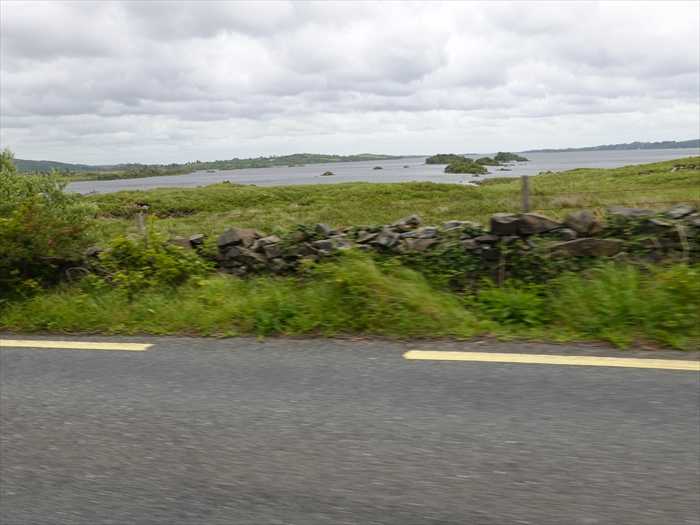
コリブ湖の北岸には大小の島々 が浮かんでいた。
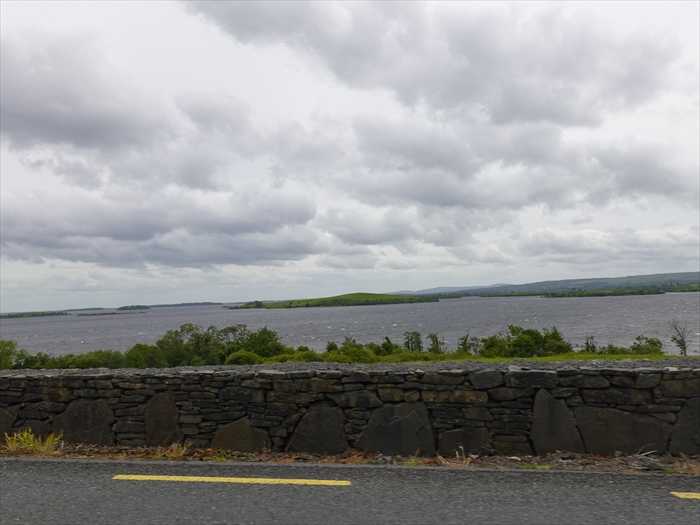
カイルモア修道院(Kylemore Abbey)~Congへのルート図を再び 。

・・・ もどる ・・・
・・・ つづく ・・・
from J. G. Howell of London designed and installed the hydro-electrical system in a small powerhouse west of the castle. We hope to reinstate hydropower in the near future to
harness sustainable green energy.」
【 湖の散策路(Lake Walk)
カイルモアの谷には三つの大きな湖(カイルモア湖、ポラカパル湖、マラドローラン湖)があり、
周囲の山からの小川が注ぎ込んでいます。
この地方は古代の部族「コンワイクネ・マーラ(海の民)」にちなんで名付けられ、大西洋に面し、
淡水と雨量に恵まれた地域です。
中でもラフ・タウザー湖(Lough Touther)は1893年、カイルモア城で水力発電に利用されました。
今後、再びこの水力発電を導入し、持続可能な再生エネルギー源として活用する予定です。】

モンテレー・パイン(Monterey Pine / Pinus radiata) であっただろうか?

そして再び カイルモア修道院・Kylemore Abbey を振り返る。

いつまでもいたい空間と時間なのであった。

そして レストランにて昼食 を。 時間は12:30過ぎ 。

駐車場に戻り、 この日の午後の目的地の「Cong Abbey」に向かってN59を西に向かって
進む 。

走行ルート図。

Kylemore Lough・カイルモア湖を右に見ながら 進む。

Kylemore Lough・カイルモア湖 の奥にそびえる大きな山の名は
ドゥールルー(Doughruagh)/デューホルーチ(Dúchruach) であろうか。

ズームして。
手前にはドゥールルーの北側から続く、なだらかな稜線の連なりが見えた。
ガラウン山群(Garraun Complex)の一部 で、標高約598 mのガラウン山が代表峰。

ガラウン山群(Garraun Complex) を追う。

対岸の ガラウン山群(Garraun Complex)の山腹の白い場所は石灰岩が剥き出し
になっている場所なのであろうか!?

Kylemore Lough・カイルモア湖 の中央付近の湖岸を走る。

更に10分ほど進むと、坂の下、前方に現れたのが、アイルランド唯一のフィヨルド、
北大西洋に繋がっている壮大なキラリー港の入江。

前方に見えたのは、サーモン?マス? の養殖場 であっただろうか。

ズームして。

Aasleagh・アアズリー方向 の山並みを見る。

右手に見えたのはアパート?ホテル?

ホテルのようであったが?

その先の、 「leenaun(リーノーン)」のT字路を右折してR336に入る 。

山々は牧草に覆われて緑一色。

Maumturk Mountains(マウムターク山脈)の山々を見る。

この山並みは「 lungnabrick SW top 454m 」周辺であっただろうか。

R336をひたすら走る。


Maumを通過し、R345 を更に進む。
Lough Corrib・コリブ湖が 右手に現れた。


ゴールウェイ州コルナモナ近郊、 コリブ湖の北岸 を進む。

R345から、 コリブ湖の北岸の景色 を楽しむ。

コリブ湖の北岸には大小の島々 が浮かんでいた。

カイルモア修道院(Kylemore Abbey)~Congへのルート図を再び 。

・・・ もどる ・・・
・・・ つづく ・・・
お気に入りの記事を「いいね!」で応援しよう
【毎日開催】
15記事にいいね!で1ポイント
10秒滞在
いいね!
--
/
--
© Rakuten Group, Inc.










